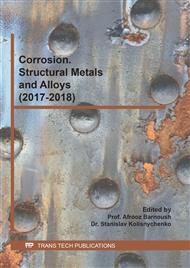[1]
S. Rohm, M. Hasler, C. Knoflach, P.J. van, S.H. Unterberger, K. Schindelwig, R. Lackner, W. Nachbauer, Friction Between Steel and Snow in Dependence of the Steel Roughness, Tribol. Lett. 59 (2015) 27-34.
DOI: 10.1007/s11249-015-0554-x
Google Scholar
[2]
R.E. Gagnon, J. Wang, Numerical simulations of a tanker collision with a bergy bit incorporating hydrodynamics, a validated ice model and damage to the vessel, Cold. Sci. Technol. 81 (2012) 26-35.
DOI: 10.1016/j.coldregions.2012.04.006
Google Scholar
[3]
H. Liang, J.M. Martin, T.L. Mogne, Experimental investigation of friction on low-temperature ice, Acta. Mater. 51 (2003) 2639-2646.
DOI: 10.1016/s1359-6454(03)00061-2
Google Scholar
[4]
J.G. Liu, Z.L. Li, Y.T. Li, B.R. Hou, Corrosion Behavior of D32 Rust Steel in Seawater, Int. J. Electrochem. Sci. 12(2014) 6699-6706.
DOI: 10.1016/s1452-3981(23)10923-0
Google Scholar
[5]
H. Su, X.B. Luo, C.F. Yang, F. Chai, H. Li, Effects of Cu on Corrosion Resistance of Low Alloyed Steels in Acid Chloride Media, J. Iron. Steel. Res. Int. 21(2014) 619-624.
DOI: 10.1016/s1006-706x(14)60096-0
Google Scholar
[6]
F. Kuang, J. Wang, L. Yan, D. Zhang, Effects of sulfate-reducing bacteria on the corrosion behavior of carbon steel, Electrochim. Acta. 52 (2007) 6084-6088.
DOI: 10.1016/j.electacta.2007.03.041
Google Scholar
[7]
G. Quercia, I. Grigorescu, H. Contreras, R.C. Di, D. Gutierrez-Campos, Friction and wear behavior of several hard materials, Int. J. Refract. Met. H. 19 (2001) 359-369.
DOI: 10.1016/s0263-4368(01)00028-2
Google Scholar
[8]
R. Tyagi, S.K. Nath, S. Ray, Dry sliding friction and wear in plain carbon dual phase steel in plain carbon dual phase steel, Metall. Matel. Transact. A. 32 (2001): 359-367.
DOI: 10.1007/s11661-001-0267-7
Google Scholar
[9]
N. Liu, J. Wang, B. Chen, F. Yan, Tribochemical aspects of silicon nitride ceramic sliding against stainless steel under the lubrication of seawater, Tribol. Int. 61 (2013) 205-213.
DOI: 10.1016/j.triboint.2013.01.011
Google Scholar
[10]
C. Gheorghies, L. Palaghian, S. Baicean, M. Buciumeanu, S. Ciortan, Fatigue behaviour of naval steel under seawater environmental and variable loading conditions, J. Iron. Steel. Res. Int. 18 (2011) 64-69.
DOI: 10.1016/s1006-706x(11)60067-8
Google Scholar
[11]
C.F. Chen, M.X. Lu, G.X. Zhao, Z.Q. Bai, M.L. Yan, Y.Q. Yang, The EIS analysis of electrode reactions of CO2 corrosion of N80 steel, Acta. Metall. Sin. 38 (2002) 770-774.
Google Scholar
[12]
C.F. Chen, M.X. Lu, D.B. Sun, Z.H. Zhang, W. Chang, Effect of chromium on the pitting resistance of oil tube steel in a carbon dioxide corrosion system, Corros. 61 (2005) 594-601.
DOI: 10.5006/1.3278195
Google Scholar
[13]
J.M. Hu, J.Q. Zhang, C.N. Cao, Determination of water uptake and diffusion of Cl- ion in epoxy primer on aluminum alloys in NaCl solution by electrochemical impedance spectroscopy, Prog. Org. Coat. 46 (2003) 273-279.
DOI: 10.1016/s0300-9440(03)00010-9
Google Scholar
[14]
G. Salvago, L. Magagnin, Biofilm effect on the cathodic and anodic processes on stainless steel in seawater near the corrosion potential - Part 2: Oxygen reduction on passive metal. Corrosion. 57(2001) 759-767.
DOI: 10.5006/1.3280610
Google Scholar
[15]
J.Y. Hu, S.A. Cao, J.L. Xie, EIS study on the corrosion behavior of rusted carbon steel in 3% NaCl solution, Anti-corros. Method. M. 60 (2013) 100-105.
DOI: 10.1108/00035591311308074
Google Scholar
[16]
A. Lopez, R. Bayon, F. Pagano, A. Igartua; A. Arredondo, J. L. Arana, J.J. Gonzalez, Tribocorrosion behaviour of mooring high strength low alloy steels in synthetic seawater, Wear. 338 (2015) 1-10.
DOI: 10.1016/j.wear.2015.05.004
Google Scholar
[17]
R.P. C. Costa, F.R. Marciano, D.A. Lima-Oliveira, E.J. Corat, V.J. Trava-Airoldi, Tribological effect of iron oxide residual on the DLC film surface under seawater and saline solutions, Sur. Sci. 605 (2011) 783-787.
DOI: 10.1016/j.susc.2011.01.018
Google Scholar
[18]
J. Chen, F.Y. Yan, B.B. Chen, J.Z. Wang, Assessing the tribocorrosion performance of Ti6Al4V, 316 stainless steel and Monel K500 alloys in artificial seawater, Mater. Corros. 64 (2013) 394-401.
DOI: 10.1002/maco.201106249
Google Scholar
[19]
E.C. Souza, S.M. Rossitti, J. Rollo, Influence of chloride ion concentration and temperature on the electrochemical properties of passive films formed on a superduplex stainless steel. Mater. Charact. 61 (2010) 240-244.
DOI: 10.1016/j.matchar.2009.12.004
Google Scholar
[20]
S.S. Xin, M.C. Li, Pitting resistance of anodic passive films formed on 316L stainless steel in the concentrated artificial seawater, Russ. J. Electrochem. 50 (2014) 281-288.
DOI: 10.1134/s1023193513090097
Google Scholar



